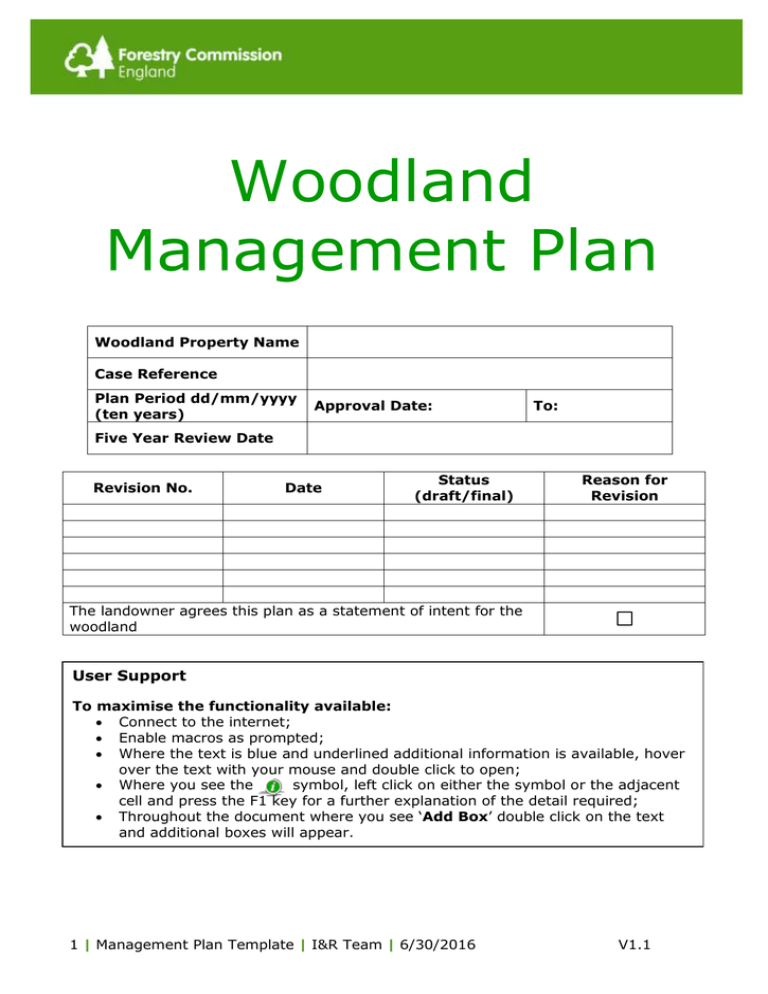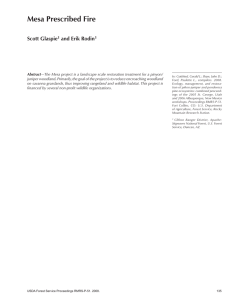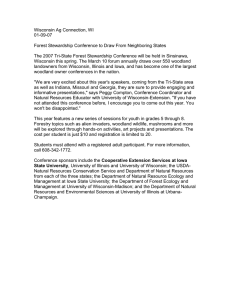Download macro enabled template
advertisement

Woodland Management Plan Woodland Property Name Case Reference Plan Period dd/mm/yyyy (ten years) Approval Date: To: Five Year Review Date Revision No. Date Status (draft/final) Reason for Revision The landowner agrees this plan as a statement of intent for the woodland User Support To maximise the functionality available: Connect to the internet; Enable macros as prompted; Where the text is blue and underlined additional information is available, hover over the text with your mouse and double click to open; Where you see the symbol, left click on either the symbol or the adjacent cell and press the F1 key for a further explanation of the detail required; Throughout the document where you see ‘Add Box’ double click on the text and additional boxes will appear. 1 | Management Plan Template | I&R Team | 6/30/2016 V1.1 UKFS Management Planning Criteria Approval of this plan will be considered against the following UKFS criteria, prior to submission review your plan against the criteria using the check list below. No. 1 2 3 4 5 6 7 8 9 UKFS Management Plan Criteria Forest management plans should state the objectives of management and set out how the appropriate balance between economic, environmental and social objectives will be achieved. Forest management plans should address the forest context and the forest potential and demonstrate how the relevant interests and issues have been considered and addressed. In designated areas, for example national parks, particular account should be taken of landscape and other sensitivities in the design of forests and forest infrastructure. At the time of felling and restocking, the design of existing forests should be reassessed and any necessary changes made so that they meet UKFS Requirements. Consultation on forest management plans and proposals should be carried out according to forestry authority procedures and, where required, the Environmental Impact Assessment Regulations. Forests should be designed to achieve a diverse structure of habitat, species and ages of trees, appropriate to the scale and context. Forests characterised by a lack of diversity due to extensive areas of even-aged trees should be progressively restructured to achieve a range of age classes. Management of the forest should conform to the plan, and the plan should be updated to ensure it is current and relevant. New forests and woodlands should be located and designed to maintain or enhance the visual, cultural and ecological value and character of the landscape. Approval Criteria Applicant Check Have objectives of management been stated? Consideration given to economic, environmental and social factors (Section 2.2) Does the management strategy (section 6) take into account the forest context and any special features identified within the woodland survey (section 4) Have appropriate designations been identified (section 4.2) if so are these reflected through the work proposals in the management strategy (Section 6) Felling and restocking are consistent with UKFS forest design principles (Section 5 of the UKFS) Has consultation happened in line with current FC guidance and recorded as appropriate in section 7 Do the felling and restocking proposals create or improve structural diversity (refer to the plan of operations) Do the felling and restocking proposals create or improve age class diversity (refer to the plan of operations) Has a 5 year review period been stated (1st page) and where relevant achievements recorded in section 3 When new planting is being proposed under this plan is it consistent with UKFS and FC guidance on woodland creation 2 | Management Plan Template | I&R Team | 6/30/2016 V1.1 1. Property Details Woodland Property Name Name Owner Email Contact Number Tenant Agent Name (if applicable) Email Contact Number County Local Authority Grid Reference Single Business Identifier Management Plan Area (Hectares) Have you included a Plan of Operations with this management plan? Yes No List the maps associated with this management plan Do you intend to use the information within the management plan and associated plan of operations to apply for the following Felling Licence Thinning Licence Woodland Regeneration Grant Tick to declare management control and agreement to public availability of the plan 3 | Management Plan Template | I&R Team | 6/30/2016 V1.1 2. Vision and Objectives To develop your long term vision, you need to express as clearly as possible the overall direction of management for the woodland(s) and how you envisage it will be in the future. This covers the duration of the plan and beyond. 2.1 Vision Describe your long term vision for the woodland(s). 2.2 Management Objectives State the objectives of management demonstrating how sustainable forest management is to be achieved. Objectives are a set of specific, quantifiable statements that represent what needs to happen to achieve the long term vision. No. Objectives (include environmental, economic and social considerations) 1 2 3 4 5 Add Box No. Objectives (including environmental, economic and social considerations) 6 7 8 9 10 11 12 13 14 15 16 4 | Management Plan Template | I&R Team | 6/30/2016 V1.1 3. Plan Review - Achievements Use this section to identify achievements made against previous plan objectives. This section should be completed at the 5 year review and could be informed through monitoring activities undertaken. Objectives Achievement Add Box 4. Woodland Survey This section is about collecting information relating to your woodland and its location, including any statutory constraints i.e. designations. 4.1 Description Brief description of the woodland property 4.2 Information Use this section to identify features that are both present in your woodland(s) and where required, on land adjacent to your woodland. It may be useful to identify known features on an accompanying map. Woodland information for your property can be found on the ‘Magic’ website or the Forestry Commission Land Information Search. Feature Biodiversity - Designations Site of Special Scientific Interest Within Woodland(s) Yes Cpts No 5 | Management Plan Template | I&R Team | 6/30/2016 Adjacent to Woodland(s) Yes Map No No V1.1 Special Area of Conservation Tree Preservation Order Conservation Area Special Protection Area Ramsar Site National Nature Reserve Local Nature Reserve Other (please Specify): Notes Yes Yes Yes Yes Yes Yes Yes Yes No No No No No No No No Within Woodland(s) Biodiversity - European Protected Species Bat Species (if known) Yes No Dormouse Yes No Great Crested Newt Yes No Otter Yes No Sand Lizard Yes No Smooth Snake Yes No Natterjack Toad Yes No Biodiversity – Priority Species Schedule 1 Birds Species Yes No Mammals (Red Squirrel, Water Yes No Vole, Pine Marten etc) Reptiles (grass snake, adder, Yes No common lizard etc) Plants Yes No Fungi/Lichens Yes No Invertebrates (butterflies, moths, Yes No beetles etc) Amphibians (pool frog, common Yes No toad) Other (please Specify): Yes No Historic Environment Scheduled Monuments Yes No Unscheduled Monuments Yes No Registered Parks and Gardens Yes No Boundaries and Veteran Trees Yes No Listed Buildings Yes No Other (please Specify): Yes No Landscape National Character Area (please Specify): National Park Yes No Area of Outstanding Natural Yes No Feature Yes Yes Yes Yes Yes Yes Yes Yes Cpts 6 | Management Plan Template | I&R Team | 6/30/2016 Map No No No No No No No No No Notes V1.1 Beauty Other (please Specify): People CROW Access Public Rights of Way (any) Other Access Provision Public Involvement Visitor Information Public Recreation Facilities Provision of Learning Opportunities Anti-social Behaviour Other (please Specify): Water Watercourses Lakes Ponds Other (please Specify): Yes No Yes Yes Yes Yes Yes Yes Yes No No No No No No No Yes Yes No No Yes Yes Yes Yes No No No No 4.3 Habitat Types This section is to consider the habitat types within your woodland(s) that might impact/inform your management decisions. Larger non-wooded areas within your woodland should be classified according to broad habitat type where relevant this information should also help inform your management decisions. Woodlands should be designed to achieve a diverse structure of habitat, species and ages of trees, appropriate to the scale and context of the woodland. Feature Woodland Habitat Types Ancient Semi-Natural Woodland Planted Ancient Woodland Site (PAWS) Semi-natural features in PAWS Lowland beech and yew woodland Lowland mixed deciduous woodland Upland mixed ash woods Upland Oakwood Wet woodland Wood-pasture and parkland Within Woodland(s) Yes Yes No No Yes Yes No No Yes No Yes Yes Yes Yes No No No No Cpts 7 | Management Plan Template | I&R Team | 6/30/2016 Map No Notes V1.1 Other (please Specify): Non Woodland Habitat Types Blanket bog Fenland Lowland calcareous grassland Lowland dry acid grassland Lowland heath land Lowland meadows Lowland raised bog Rush pasture Reed bed Wood pasture Upland hay meadows Upland heath land Unimproved grassland Peat lands Wetland habitats Other (please Specify): Yes No Yes Yes Yes Yes Yes Yes Yes Yes Yes Yes Yes Yes Yes Yes Yes Yes No No No No No No No No No No No No No No No No 8 | Management Plan Template | I&R Team | 6/30/2016 V1.1 4.4 Structure This section should provide a snapshot of the current structure of your woodland as a whole. A full inventory for your woodland(s) can be included in the separate Plan of Operations spreadsheet. Ensuring woodland has a varied structure in terms of age, species, origin and open space will provide a range of benefits for the biodiversity of the woodland and its resilience. The diagrams below show an example of both uneven and even aged woodland. Percentage of Mgt Woodland Type Notes (i.e. understory or natural Age Structure Plan Area Please Select.... Please Select.... Please Select... Please Select.... Please Select... Please Select.... Please Select... Please Select.... Please Select... regeneration present) Please Select... 9 | Management Plan Template | I&R Team | 6/30/2016 V1.1 5. Woodland Protection Woodlands in England face a range of threats; this section allows you to consider the potential threats that could be facing your woodland(s). Using the simple Risk Assessment process below woodland owners and managers can consider any potential threats to their woodland(s) and whether there is a need to take action to protect their woodlands. 5.1 Risk Matrix The matrix below provides a system for scoring risk. The matrix also indicates the advised level of action to take to help manage the threat. Impact High Medium Plan for Action Monitor Action Plan for Action Action Action Low Monitor Monitor Plan for Action Low Medium High Likelihood of Presence 5.2 Plant Health Threat (Other Please Specify) Likelihood of presence Impact Response (inc protection measures) Add Box Threat (Other Please Specify) Likelihood of presence Impact Response (inc protection measures) Add Box Threat (Other Please Specify) Likelihood of presence Impact Response (inc protection measures) Add Box Threat (Other Please Specify) Likelihood of presence Please Select.... Please Select.... Please Select.... Please Select.... Please Select.... Please Select.... Please Select.... Please Select.... Please Select.... Please Select.... Please Select.... 10 | Management Plan Template | I&R Team | 6/30/2016 V1.1 Impact Response (inc protection measures) Please Select.... 5.3 Deer Likelihood of presence Impact Response (inc protection measures) Please Select.... Please Select.... 5.4 Grey Squirrels Likelihood of presence Impact Response (inc protection measures) Please Select.... Please Select.... 5.5 Livestock and Other Mammals Threat (Other Please Specify) Likelihood of presence Impact Response (inc protection measures) Add Box Threat (Other Please Specify) Likelihood of presence Impact Response (inc protection measures) Please Select.... Please Select.... Please Select.... Please Select.... Please Select.... Please Select.... 5.6 Water & Soil Threat (Other Please Specify) Likelihood of presence Impact Response (inc protection measures) Add Box Threat (Other Please Specify) Likelihood of presence Impact Response (inc protection measures) Add Box Please Select.... Threat Please Select.... Please Select.... Please Select.... Please Select.... Please Select.... Please Select.... 11 | Management Plan Template | I&R Team | 6/30/2016 V1.1 (Other Please Specify) Likelihood of presence Impact Response (inc protection measures) Please Select.... Please Select.... 5.7 Environmental Threat (Other Please Specify) Likelihood of presence Impact Response (inc protection measures) Add Box Threat (Other Please Specify) Likelihood of presence Impact Response (inc protection measures) Add Box Threat (Other Please Specify) Likelihood of presence Impact Response (inc protection measures) Please Select.... Please Select.... Please Select.... Please Select.... Please Select.... Please Select.... Please Select.... Please Select.... Please Select.... 5.8 Climate Change Resilience Threat (Other Please Specify) Likelihood of presence Impact Response (inc protection measures) Add Box Threat (Other Please Specify) Likelihood of presence Impact Response (inc protection measures) Add Box Please Select.... Threat (Other Please Specify) Likelihood of presence Please Select.... Please Select.... Please Select.... Please Select.... Please Select.... Please Select.... Please Select.... 12 | Management Plan Template | I&R Team | 6/30/2016 V1.1 Impact Response (inc protection measures) Please Select.... 6. Management Strategy This section requires a statement of intent, setting out how you intend to achieve your management objectives and manage important features identified within the previous sections of the plan. A detailed work programme by sub-compartment can be added to the Plan of Operations. Management Obj/Feature Management Intention Add Box 13 | Management Plan Template | I&R Team | 6/30/2016 V1.1 7. Stakeholder Engagement There can be a requirement on both the FC and the owner to undertake consultation/engagement. Please refer to Operations Note 35 for further information. Use this section to identify people or organisations with an interest in your woodland and also to record any engagement that you have undertaken, relative to activities identified within the plan. Work Proposal Individual/ Organisation Date Contacted Date feedback received Response Add Box 14 | Management Plan Template | I&R Team | 6/30/2016 V1.1 Action 8. Monitoring Indicators of progress/success should be defined for each management objective and then checked at regular intervals. Other management activities could also be considered within this monitoring section. The data collected will help to evaluate progress. Management Objective/Activities Indicator of Method of Progress/Success Assessment Frequency of Assessment Add Box 15 | Management Plan Template | I&R Team | 6/30/2016 V1.1 Responsibility Assessment Results FC Approval – FC Office Use Only UKFS Management Plan Criteria Forest management plans should state the objectives of management, and set out how the appropriate balance between economic, environmental and social objectives will be achieved. Forest management plans should address the forest context and the forest potential, and demonstrate how the relevant interests and issues have been considered and addressed. In designated areas, for example national parks, particular account should be taken of landscape and other sensitivities in the design of forests and forest infrastructure. At the time of felling and restocking, the design of existing forests should be re-assessed and any necessary changes made so that they meet UKFS Requirements. Consultation on forest management plans and proposals should be carried out according to forestry authority procedures and, where required, the Environmental Impact Assessment Regulations. Forests should be designed to achieve a diverse structure of habitat, species and ages of trees, appropriate to the scale and context. Forests characterised by a lack of diversity due to extensive areas of even-aged trees should be progressively restructured to achieve a range of age classes. Management of the forest should conform to the plan, and the plan should be updated to ensure it is current and relevant. New forests and woodlands should be located and designed to maintain or enhance the visual, cultural and ecological value and character of the landscape. Approving Officer Name Approval Criteria Have objectives of management been stated? Consideration given to economic, environmental and social factors (Section 2.2) Does the management strategy (section 6) take into account the forest context and any special features identified within the woodland survey (section 4) Have appropriate designations been identified (section 4.2) if so are these reflected through the work proposals in the management strategy (Section 6) Felling and restocking are consistent with UKFS forest design principles (Section 5 of the UKFS) Yes No Notes Has consultation happened in line with current FC guidance and recorded as appropriate in section 7 Do the felling and restocking proposals create or improve structural diversity (refer to the plan of operations) Do the felling and restocking proposals create or improve age class diversity (refer to the plan of operations) Has a 5 year review period been stated (1st page) and where relevant achievements recorded in section 3 When new planting is being proposed under this plan is consistent with UKFS and FC guidance on woodland creation Plan approved 16 | Management Plan Template | I&R Team | 6/30/2016 V1.1





